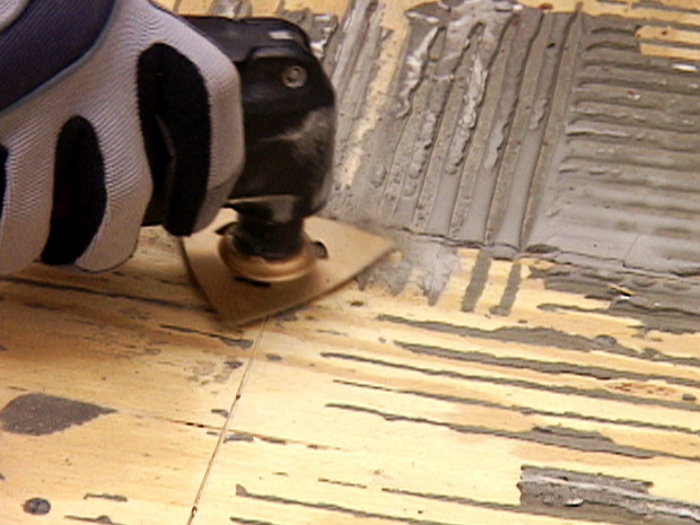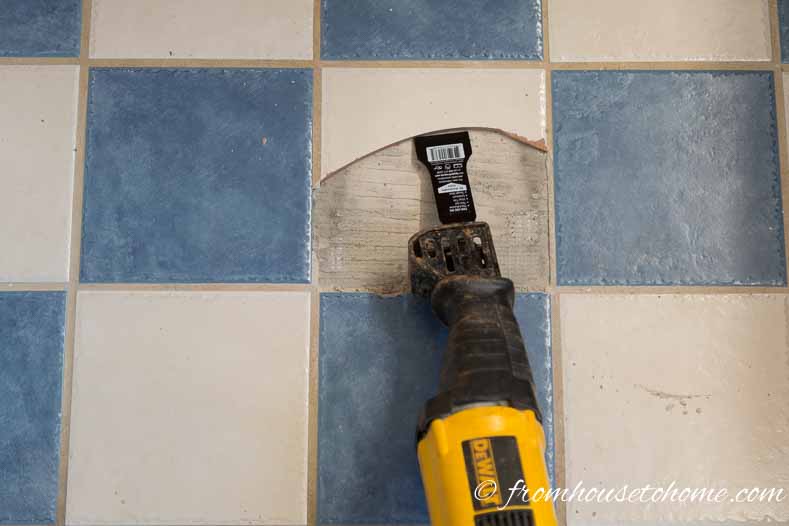

The one downside was that the sledgehammer shook the floor so badly that 30 years of dust and debris fell from the basement rafters and coated everything down there (which includes all of the kitchen stuff we moved out for the reno) - but we’ll get it cleaned up eventually. It still took him a few hours of bashing, but he got it done. And we had more 350 square feet to deal with, and fewer than one million years to get it done. But he gave that a try, and it turns out all those other idiots had figured out already that it takes approximately 1 million years to chisel the tiles out one by one. I was very specific with him that unlike all those other idiots online who seemed to just bash up their tile with a sledgehammer and then have a mess of shards to deal with, we should very carefully remove them with a chisel to keep things nice and tidy. So Saturday morning while my dad and I started working on cabinetry, Sam did this: We decided we agreed, and since redoing the floor would require moving everything out of the kitchen and dining area all over again, we thought it made sense to just get the work done as quickly as possible so we could start to return the rooms to some semblance of normalcy - rather than temporarily move everything back in only to have to go through all the relocation work a second time. While there were a lot of creative suggestions from you awesome readers, the overwhelming consensus was that we should just bite the bullet and invest in a new floor since we didn’t love the old one to begin with.
#Removem thinset from tile how to
Basically, our demo was going to leave us with a few gaps in the floor tile, and we couldn’t find matching tile anywhere so we just didn’t know how to proceed. Oh, the floor.Īs you probably recall, we had major angst related to the floor, which I shared all about and got amazingly helpful feedback from you guys about. I’ll be back next week to share on those, and in the meantime today I’m talking about the floor. But I’m not posting about either of those projects today, because this post would be way too long. (He’s also the genius behind my amazing workbench, so clearly he has some serious carpentry skills, it’s just a first foray into cabinets.) And we had someone come to measure for our new counters, which was also interesting to observe. My dad was in town so that together could try our hand at making cabinets for the first time for the pantry wall. That said, we did make a lot more progress over this past weekend immediately following the wall demo, and I wanted to share a little bit today. So…we’re looking at a long time before we can call this baby complete! The rest we’re doing ourselves, and I put together a to-do list that has at least 25 projects on it that will take a weekend or more to complete. But I’m worried I may have spoiled you - that was the one part of the job we hired professionals to do, and it shows in terms of speed.
#Removem thinset from tile update
In case you missed it, I posted every day that week to update on the progress: here, here, here, here, and here.Īnd readers were so encouraging about the progress and how fast it was going.

The only thing I want to add is controlling the floor buffer takes some practice! They don't really mention it in the user manual, but you really have to put your body weight into it to stop it from spinning out of control and flying across the room.As you know, a lot changed in our kitchen last week when we took down the wall dividing the sunroom and kitchen.

It worked great and I'd definitely recommend it for anyone else who might be reading this later with a similar problem. Is there anyone that has dealt with this specific situation before that has a definitive tested solution that will result in me having a clean slab of concrete? (ideally as cheap as possible! :) )ĮDIT: Thanks for all the feedback guys! I ended up renting a floor buffer as u/bad_finger suggested. I've found I can pick at it with a scraper tool I picked up from my local hardware store but it's extremely inefficient and is going to take a lot of time and effort this way.ĭoes anyone know what the easiest way to remove this layer of thinset is? I've heard about renting sanders, buffers, attaching air hammers to the scraper, as well as some suggestions on chemicals that might work. Removing the tiles itself was pretty straightforward, but there is big layer of thinset underneath. I recently removed tile flooring from a room in my house.


 0 kommentar(er)
0 kommentar(er)
